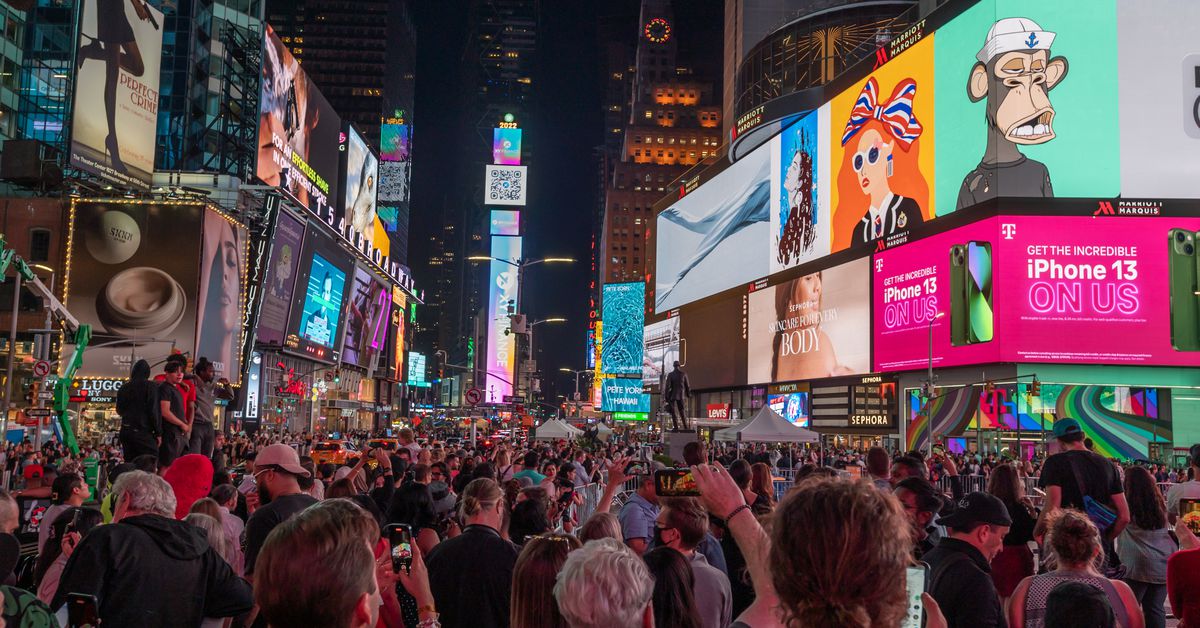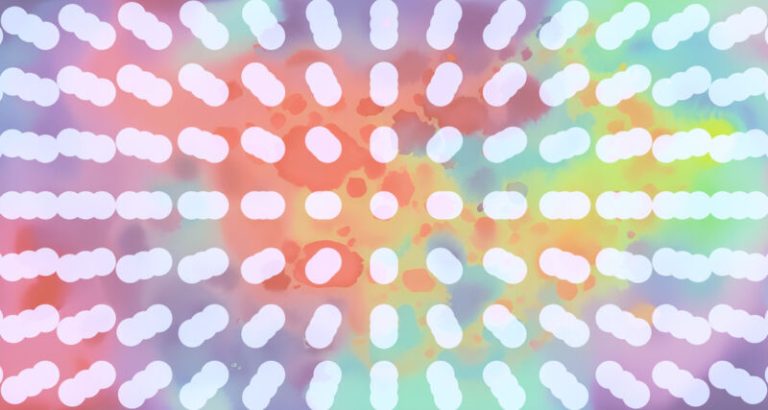
On a rainy Tuesday in June, I found myself in a packed and buzzing Times Square theater, having skipped a line that wrapped seemingly endlessly around the city block thanks to a very handy press pass. The occasion: an event hosted by Doodles, a collection of 10,000 brightly colored NFTs.
To say I didn’t get the commotion is an understatement — one of Doodles’ most prominent images appears to be one of a cartoon vomiting a rainbow, and among its founders is a guy who goes by “poopie” on Twitter. But attendees assured me this was a very exciting moment. Some were jazzed about what they said would be a highly anticipated new phase of the project, while others speculated about who the promised musical act would be. Ultimately, the audience was treated to video messages from Serena Williams’ husband (a new investor) and Pharrell (new chief brand officer) and a performance by The Chainsmokers. The company also promises more NFTs, music projects, and art, a lot of which is TBD.
“Doodles is here to color our world, it’s here to help us channel our inner child, and ultimately help us understand that anything is possible with the power of our imagination,” said Doodles CEO Julian Holguin in what amounted to a glorified TED talk. He joined the project in May after coming over from Billboard. “The market needs that right now, the world needs right now,” he added. The market line elicited laughs from the crowd. It is, as you may know, a less-than-ideal time to be investing in NFTs, crypto, or, really, most investments lately.
“We’re kind of speculating on the cultural impact that Doodles makes on music, sports, gaming,” David, a Doodle holder who had traveled to New York from Los Angeles for the week, told me. He excitedly explained to me what was going on throughout the evening, after the Pharrell announcement leaning over to whisper the floor price of the NFTs had just crept up. “We hope that the future is something that delivers greater good.”
Web3 (the supposed next version of the internet) and NFTs (unique digital bits), is pretty scammy and predatory. A lot of it’s based on some future promise of “utility” that in most current iterations translates to nothing more than hype. That hype is generated by a select few on the backs of the masses, some desperate to be part of contrived communities. It fails at its basic premise of decentralization and taking the power out of the hands of concentrated authorities. NFT NYC, the context in which the Doodles event was held, was a prime example: Thousands of attendees paid hundreds and even thousands of dollars to attend a conference that can only be described as pure chaos. Some attendees criticized it as a cash grab by its handful of organizers.
Still, if you immerse yourself in the arena for a bit, you can start to see why some of this works. Everything has felt so bad for so long, everyone seems so disconnected. People want to feel excited, and if a rainbow drawing that says it’s doing an album with Pharrell does it for you, why not? We feel an inherent desire to be a part of something, to belong, and we often spend money to achieve that.
Amid the current market crash, being in a room full of unconcerned NFT fans feels a bit like the “this is fine” meme in live action. Then again, so does everything else.
NFT people still feel super good about all of this, they promise
For four days in late June, thousands of people descended onto Midtown Manhattan for the fourth installment of NFT NYC, an event that claims to be one of the biggest in non-fungible tokens. Organizers claimed 15,000 people were set to attend, and they had a lineup of 1,500 speakers. If this all seems like a bit much, it’s because it was. It was often easier to navigate the tourist-ridden streets of Times Square than the hallways of the multi-floor, casino-like Marriott Marquis Hotel, where the conference was based. Most speakers were given just a handful of minutes on stage, largely addressing half-empty conference rooms at best.
Well-funded people in the arena say they anticipated the downturn and even welcome it. “There’s so much noise in the NFT space, in the crypto space, right now, and if anything, what this crypto winter represents is the ability to shake some of that out,” said Jason Melo, chief technology officer at VHS, the company behind Zed Run, a digital horse racing game. Phillip Shoemaker, the executive director of Identity.com, an identity verification company focused on Web3, and former head of the Apple App Store, echoed the sentiment. “Everybody that was an OG crypto person saw this coming,” he said.
I believe both when they insist they’re trying to build out real-ish projects in the burgeoning Web3 space. Gambling is fun, so why not on digital horses? Shoemaker really does seem to care about pseudonymity.
However, both can also afford to lose, a privilege that normies and new entrants in the area with much shallower pocketbooks don’t necessarily have. Web3 absolutely needs some shaking out. The ones who are going to be shaken out are those who might be able to least afford it.
Austin Kuechle, one of the founders of Galactic Gaylords, an NFT project aimed at the queer community, spent thousands of dollars for a sponsorship booth (of which there were dozens upon dozens) and for his team to attend NFT NYC. Kuechle, who goes by Austin Please online and describes himself as a “gay dad from Canada,” just quit his job as a mechanical engineer to get more into Web3, though he still has an e-commerce business on the side. His timing isn’t great, but he’s determined to forge ahead. “For a long-term project like us, I’m not too worried about it,” he said. The actual NFTs aren’t available yet.
Galactic Gaylords will be “story driven,” and the team will hire LGBTQIA writers to “tell their queer journey within the constraints of our super gay galaxy,” he explained. The ultimate goal is to get a Netflix show. In the meantime, they plan to send physical playing cards to NFT holders quarterly. I tell him I don’t really get it. He tells me I’m just not there yet. “Until you dive into it, you might not feel it.”
Yet again, I believe him. I also don’t get people who go to Phish concerts or collect Pokémon cards, both of which have thriving communities around them. The culture surrounding many higher-profile NFT projects, whether it be Bored Apes or Doodles or whatever else, is hyper-monetized fandom. Web3 in many circumstances may be a cynical cash grab from those at the top, but at the bottom of a pyramid are a lot of people who are at least, in part, true believers.
“The Web3 community is so small that the people in it are the ultra-passionate ones, so they’re almost willing to jump at anything,” said Lauren Mitchell, one of the forces behind Save Web3, which purports to try to keep the Web3 promise of decentralization and community alive.
But then in the middle of a Herald Square hotel diner, Mitchell hits the nail on the head. “There’s a lot of people benefiting from the desire people have for community coming out of the pandemic,” she says. Stockfield comes in with a different, and likely also correct, angle. “There’s a tight-knit club of people that are pulling the strings.”
NFTs are gambling and so is gambling
I absolutely still do not want a Doodle, and most people in the space agree that approximately 99 percent of this will not exist in five to 10 years. But I am going to say something that I probably should not: I empathize with the hope of what it maybe could be, and with why that hope exists in the first place.
The internet right now is a real bummer — giant tech companies rule everything, privacy is a lie, and Facebook has maybe ruined democracy. It’s so hard to make it as a musician or an artist. It feels like the economy and society are crumbling around us. Crypto and DeFi and Bored Apes and whatever else are absolutely unequal and pyramid-y and unfair and bad for the environment. The same goes for so many aspects of big business and capitalism. The metaverse is maybe not great, and neither is the real world. Crypto might be particularly bad in terms of regulation and consumer protection, but also we let people get screwed over by predatory financial services and investments all the time. It’s all more of the same.
In the midst of the NYC NFT event, I sought out a moment of quiet in one of the side conference rooms, which were generally empty. There, I encountered Stephan Ledain, who works with an NFT project called the Jenny Metaverse DAO. It deals with fractionalized shares — meaning multiple people can have a stake in it — of art.
Ledain, who works at a consulting firm, is enthusiastic about the project and also aware it might not work. He’s also clear-eyed about what’s going on in NFTs. “Every nascent industry has this gold rush, capitalist energy around it,” he said. In his view, the art market as it is today is broken in the first place, so why not see if Web3 can help fix it?
It makes it hard not to root for the underdog, even if the underdog is banking on a future that very well may not pan out.
We live in a world that’s constantly trying to sucker us and trick us, where we’re always surrounded by scams big and small. It can feel impossible to navigate. Every two weeks, join Emily Stewart to look at all the little ways our economic systems control and manipulate the average person. Welcome to The Big Squeeze.
Sign up to get this column in your inbox.
Have ideas for a future column? Email emily.stewart@vox.com.






